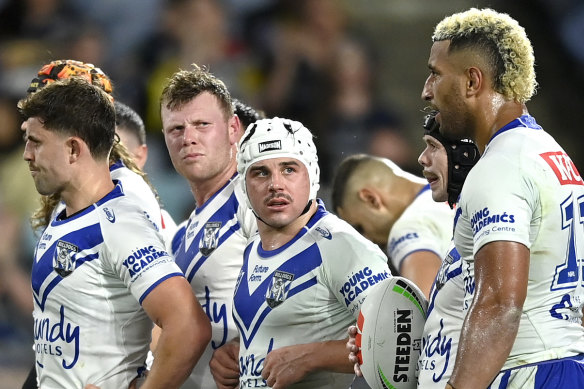By Dan Walsh
Someone, somewhere, has surely said it. After innovation, comes correction, and innovation again.
This might just be where Canterbury find themselves after turning the worst defence of 2023 into the best defence of 2024.
And then watching it get smashed to pieces in two weeks as oppositions adjusted their game plans accordingly.
To a man, the Bulldogs have insisted that recovering from the 78 points leaked against Manly and North Queensland is “an easy fix”.
It might be. Or we might see the rot started two weeks ago by the Sea Eagles end Canterbury’s fairytale campaign in ruthless fashion unless they can work it out.
Will a good big man always beat a good little man?
As detailed previously by this masthead, Canterbury’s ‘check, release and respond’ defensive system – the same Ciraldo championed during his time at Penrith – has been the backbone of their first finals appearance since 2016.
It’s a physically taxing system founded on repeat efforts, fitness and a pack mentality – in which the likes of Reed Mahoney, Jaeman Salmon, Bailey Hayward, Kurt Mann and Kurtis Morrin all weigh in at less than 100 kilos.
And it succeeds despite the Bulldogs having the most missed tackles in the NRL (39 per game) because they’re able to swarm attacking sides with their line speed and then scramble to cover each other if a hole is found.
Until the Sea Eagles got hold of them two weeks ago, the Bulldogs’ 16.13 points conceded a game made theirs the stingiest defence in the competition.
Ciraldo singled out Daly Cherry-Evans’ game management after Manly put the cleaners through his side in round 26, the 34-22 scoreline flattering Canterbury thanks to two late tries and Tom Trbojevic’s shoulder injury as well.
Manly might just be the NRL’s flightiest attacking side, with its quickest backline, licence to use it and points for days.
Last time they were at Accor Stadium though, they changed tact from swinging wide to their edges and came straight down Broadway.
Taniela Paseka (197cm, 120 kg), Nathan Brown (185cm, 104kg), Haumole Olakau’atu (196cm, 113kg) and Matt Lodge (191cm, 117kg) helped themselves to a combined 607 running metres against the Bulldogs lightweight pack.
Plenty of that was after contact too, translating to a 3.16-second average play-the-ball speed, significantly quicker than Canterbury’s 3.5.
Quick play-the-balls like Paseka’s in the lead-up to an early Trbojevic try had Canterbury’s defence back-pedalling and eventually, coughing up its biggest asset when Manly, and then North Queensland a week later, came calling through the middle of the ruck.
Until the last Manly game, the Bulldogs’ 1443 run metres conceded was the second-best in the NRL, behind only Penrith.
The Sea Eagles finished with 1654m that night, outpointing Canterbury with 574 of them after contact, even though the Dogs finished with better overall yardage metres once the game was gone and possession evened up.
“You take it personally, you have to,” Viliame Kikau says of Olakau’atu’s dominance down his left-side corridor.
“He ran amok on our edge. When you go out on the field you just want to be better than your opposite number and he was the better one last time.
“They used their big middles to generate their ruck speed and that was disappointing.”
North Queensland found even greater fortune through Canterbury’s middle last weekend.
The Bulldogs hung tough for a while, but the likes of Griffin Neame, Reuben Cotter, Heilum Luki and Jason Taumalolo repeatedly rolled through for quick play-the-balls and repeated assaults on tired defenders.
“It’s attitude, that’s how we’ve kept up with bigger sides this year and that’s where we weren’t up for it attitude-wise in defence,” Tracey says.
“We’ve held our gloves up for the rest of the year in the middle so those two games sting. But we’ve had our reviews and our honest conversations, and it’s a finals game.
“There’s naturally going to be so much intent and that’s what our defensive style is based on.”
The easy fix: Is it just that simple?
For all the focus on the Sea Eagles’ and Cowboys’ dominance through Canterbury’s middle, the Bulldogs are just as concerned with how accommodating they were as hosts.
Canterbury opened the scoring in just 94 seconds against Manly, but had only one set that night between the fourth and 12th minute thanks to two handling errors, a penalty and set-restart.

The Bulldogs ball control has hurt them as much as anything in the past fortnight.Credit: NRL Imagery
By the 18th minute Bronson Xerri was on report among a few more infringements, Manly had three tries and a 70 per cent share of possession that Canterbury never recovered from.
It was a similar story against North Queensland as they put 44 past them and Canterbury’s 15 errors ensured they only completed at 63 per cent.
“Any defensive system gets tested when we don’t have possession, and especially ours given how much hard work and cohesion is needed for it,” Tracey says.
Skipper Stephen Crichton adds: “Just holding the ball the past two weeks, we probably conceded the most errors throughout the whole season for us, and that’s unlike us.
“If we can just fix that up, we won’t be defending as much as well. It will definitely make our jobs easier.”
It certainly wouldn’t hurt. Now all eyes are on whether the NRL’s hardest-working defence can recover in a week from the past fortnight.
Or if finding the solution against the game’s best and biggest packs is going to take Ciraldo all summer long.
NRL is Live and Free on Channel 9 & 9Now
Sports news, results and expert commentary. Sign up for our Sport newsletter.